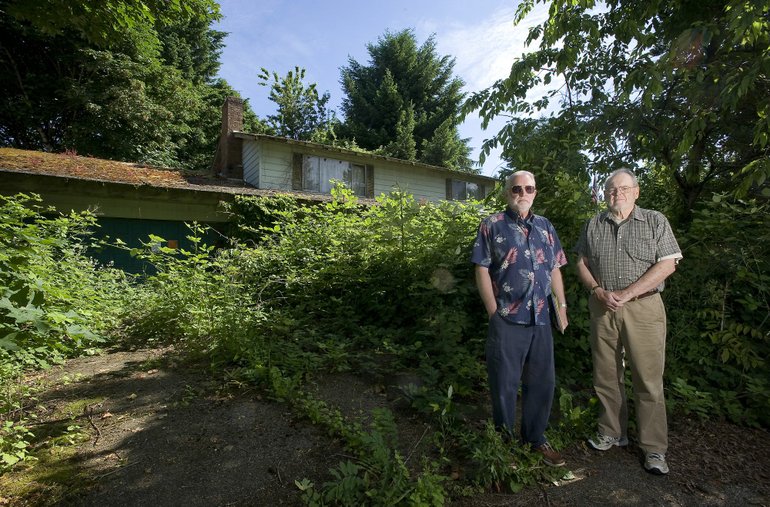MARRION — Jim Faull and Ed McMillan’s street in the Marrion neighborhood is the kind where neighbors keep their yards mowed, folks hang signs proclaiming “Welcome!” and flag poles dot the landscape.
Then there’s the house that they jokingly call “The Castle.” It’s been almost two years since they’ve seen the owner — she got into a car carrying suitcases, they say, and never came back.
Now, raccoons and opossums are the only ones to call it home. The Castle’s not just overgrown — it’s a jungle in there. Blackberries climb halfway up the two-story home. There’s a hole in the roof.
It wasn’t maintained before the owner, Deborah Hansen, disappeared. But it’s gotten worse.
“This house has been in violation of city codes for years,” Faull said. “I just had not done anything with the city until she abandoned the place.”
Faull started filing complaints in October 2009. Just last month, he got action.
Vancouver building officials have posted signs on the house, on Northeast 16th Street, saying it’s uninhabitable. Hansen had until today to either respond or demolish the house and its excessive shrubbery.
But the Marrion neighborhood is lucky, in a way. Because the Hansen house is the most dangerous and egregious violation in the city, it’s at the top of the list and will be the recipient of the city’s meager dangerous building fund, building official Cindy Meyer said.
In four years, the city council has approved cutting the fund from $100,000 to $25,000. This year, all of that money will go to handling this one house, Meyer said.
“We really have to prioritize and say we can only deal with the very worst of cases,” she said. “We’re not sure whether we’re going to be able to take care of the abatement for $25,000 — it’s a huge task.”
But the rest of the roughly 2,500 to 3,000 complaints the city gets about overgrown lawns or dilapidated porches will have to wait.
Life safety issues such as substandard buildings, health hazards from garbage, and hazards to motorists and pedestrians are the highest priority for the city’s code compliance officers. Tall vegetation is the lowest priority and is handled when there is time, Meyer said.
Adding to the city’s problem is foreclosed properties that have been abandoned, but are still working their way through the court system to transfer ownership to the bank, she said. During that time, no one is technically responsible to keep the property cleared, meaning there’s not a lot the city can do.
Meyer said her department can’t locate Hansen, either. She’s not in foreclosure, but she’s three years behind on her property taxes. County records show the property is worth $65,000 and the house is worth nothing.
Her absence means that it may take a bit longer to get a court order to demolish the house. It also means that it may be hard for the city to recover its costs of abatement on the property — it will be placed as a lien against the property, so if it is ever sold the money would have to be paid.
But Faull, retired from the Air Force, and McMillan, a retired county engineer, are appalled that the city’s elected officials aren’t making blighted properties a higher priority.
“These are the kinds of things that should be a political issue,” McMillan said. “The city council represents us, and it’s their job to pay attention to it.”
McMillan, who worked in code compliance during his career, suggested the city start a revolving fund where it takes $100,000 to buy and demolish overgrown properties, and then repay the fund when it sells the lot.
Faull said he’s lived in his house next to “The Castle” for 20 years, and is glad he isn’t in the market to move.
“I’m not interested, and I’m glad I’m not,” he said, looking over at the tangle of weeds that makes up his next-door neighbor.
“With the real estate market as it is, you’d think (the city) would want property to look as good as possible,” McMillan added.
The neighborhood is glad to hear that this one eyesore will go. For the rest, the city’s Meyer said that all neighborhoods across Vancouver, from the poorest to richest, can face problem properties.
“We just ask that people take responsibility for their property, and keep their grass mowed,” she said.



